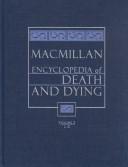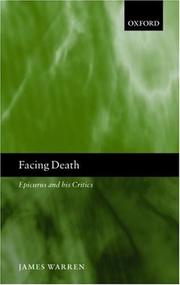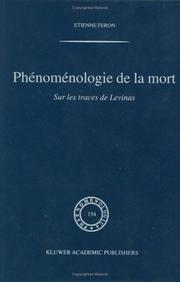| Listing 1 - 10 of 10 |
Sort by
|
Book
ISSN: 00791687 ISBN: 9789004282179 9789004289543 9004282173 9004289542 Year: 2015 Volume: v 140 Publisher: Leiden, Netherlands ; Boston, [Massachusetts] : Brill,
Abstract | Keywords | Export | Availability | Bookmark
 Loading...
Loading...Choose an application
- Reference Manager
- EndNote
- RefWorks (Direct export to RefWorks)
Plato’s Phaedo has never failed to attract the attention of philosophers and scholars. Yet the history of its reception in Antiquity has been little studied. The present volume therefore proposes to examine not only the Platonic exegetical tradition surrounding this dialogue, which culminates in the commentaries of Damascius and Olympiodorus, but also its place in the reflections of the rival Peripatetic, Stoic, and Sceptical schools. This volume thus aims to shed light on the surviving commentaries and their sources, as well as on less familiar aspects of the history of the Phaedo ’s ancient reception. By doing so, it may help to clarify what ancient interpreters of Plato can and cannot offer their contemporary counterparts.
Immortality (Philosophy) --- Death. --- Immortalité (Philosophie) --- Mort --- Plato. --- Death --- Platon, --- Immortalité (Philosophie) --- Döden. --- Griechisch. --- Immortality (Philosophy). --- Latein. --- Literatur. --- Odödlighet (filosofi). --- Rezeption. --- Plato, --- Phaedo (Plato). --- Platon --- Dying --- End of life --- Life --- Terminal care --- Terminally ill --- Thanatology --- Philosophy --- Plato. - Phaedo

ISBN: 002865689X 0028656903 0028656911 0028658817 0028664213 9780028656892 Year: 2003 Publisher: New York ; London ; Munich Macmillan Reference USA Thomson Learning
Abstract | Keywords | Export | Availability | Bookmark
 Loading...
Loading...Choose an application
- Reference Manager
- EndNote
- RefWorks (Direct export to RefWorks)
Thanatology. --- Death --- Cross-cultural studies. --- Death studies --- Death--Study and teaching --- Dood--Studie en onderwijs --- Mort--Etude et enseignement --- Tanatologie --- Thanatologie --- Encyclopédias --- 393 <031> --- -Thanatology --- Dood. Dodengebruiken. Dodenritueel. Lijkverbranding. Begrafenis. Crematie. Rouw. Opbaren. Lijkstoet. Sterven. Dodenmaskers--Encyclopedieën. Lexica --- 393 <031> Dood. Dodengebruiken. Dodenritueel. Lijkverbranding. Begrafenis. Crematie. Rouw. Opbaren. Lijkstoet. Sterven. Dodenmaskers--Encyclopedieën. Lexica --- Encyclopédias --- Thanatology --- Dying --- End of life --- Life --- Terminal care --- Terminally ill --- Cross-cultural studies --- Study and teaching --- Philosophy --- Mort --- Encyclopedias --- Encyclopédies --- Death - Cross-cultural studies.

ISBN: 0199252890 9780199252893 019929769X 9780199297696 0191601403 9786611989934 1281989932 0191531006 Year: 2004 Publisher: Oxford Clarendon
Abstract | Keywords | Export | Availability | Bookmark
 Loading...
Loading...Choose an application
- Reference Manager
- EndNote
- RefWorks (Direct export to RefWorks)
(Publisher-supplied data) The ancient philosophical school of Epicureanism tried to argue that death is "nothing to us." Were they right? James Warren provides a comprehensive study and articulation of the interlocking arguments against the fear of death found not only in the writings of Epicurus himself, but also in Lucretius' poem De rerum natura and in Philodemus' work De morte. These arguments are central to the Epicurean project of providing ataraxia (freedom from anxiety) and therefore central to an understanding of Epicureanism as a whole. They also offer significant resources for modern discussions of the value of death--one which stands at the intersection of metaphysics and ethics.
Death. --- Epicureans (Greek philosophy) --- Epicurus. --- Epicurean philosphers --- Epicureanism --- Epicureeërs (Griekse filosofie) --- Epicuriens (Philosophie grecque) --- Epicurisme --- Epikureismus --- Philosophes épicuriens --- Philosophie épicurienne --- École épicurienne --- Épicurisme --- Épicurisme (Philosophie grecque) --- Épicuréisme --- Mort --- Epicuriens --- Death --- Philosophy, Ancient --- Dying --- End of life --- Life --- Terminal care --- Terminally ill --- Thanatology --- Philosophy --- Epicurus --- Ἐπίκουρος --- Epikouros --- Epikuros --- Ėpikur --- Epiḳoros --- Epicuro --- Abīqūr --- Yibijiulu --- Epicure --- Epʻikʻurosŭ --- Attitude to Death. --- Philosophy. --- Epicureans (Greek philosophy). --- Doodsangst. --- Epicurisme. --- Klassieke oudheid. --- Mort. --- Épicuriens. --- Tod. --- Philosophie. --- Epikureer. --- Epicurismo. --- Filosofia grega. --- Épicure. --- Epicuro.

ISBN: 0521808081 9780521808088 Year: 2001 Volume: 18 Publisher: Cambridge New York Melbourne Cambridge University Press
Abstract | Keywords | Export | Availability | Bookmark
 Loading...
Loading...Choose an application
- Reference Manager
- EndNote
- RefWorks (Direct export to RefWorks)
Women --- Femmes --- Biography --- History --- Biographie --- Histoire --- Freke, Elizabeth. --- England --- Angleterre --- Social conditions --- Conditions sociales --- Terminal care --- Gentry --- Married women --- Widows --- Human females --- Wimmin --- Woman --- Womon --- Womyn --- Females --- Human beings --- Femininity --- Marital status --- End-of-life care --- Terminally ill --- Care of the sick --- Critical care medicine --- Death --- Married people --- Wives --- Gentry, Landed --- Landed gentry --- Squires --- Upper class --- Care and treatment --- Medical care --- Freke, Elizabeth, --- Norfolk (England) --- Norfolk --- County of Norfolk (England) --- Social life and customs --- Freke, Elizabeth --- 18th century --- Sources --- Terminal care - England - Norfolk - History - 18th century - Sources. --- Gentry - England - Norfolk - History - Sources. --- Women - England - Norfolk - History - Sources. --- Married women - England - Norfolk - Biography. --- Widows - England - Norfolk - Biography. --- Veuves --- 18e siecle
Book
ISBN: 9789004163706 9004163700 Year: 2008 Volume: 161 Publisher: Leiden Boston Brill
Abstract | Keywords | Export | Availability | Bookmark
 Loading...
Loading...Choose an application
- Reference Manager
- EndNote
- RefWorks (Direct export to RefWorks)
Jews --- Jewish sepulchral monuments --- Tombs --- Death --- Judaism --- Excavations (Archaeology) --- Juifs --- Monuments funéraires juifs --- Tombeaux --- Mort --- Judaïsme --- Fouilles (Archéologie) --- History --- Religious aspects --- Judaism. --- Histoire --- Aspect religieux --- Africa, North --- Afrique du Nord --- Antiquities, Roman. --- Antiquités romaines --- Ethnic relations. --- 939.7 --- History Ancient world North Africa --- Monuments funéraires juifs --- Judaïsme --- Fouilles (Archéologie) --- Antiquités romaines --- Religions --- Semites --- Hellenistic Judaism --- Judaism, Hellenistic --- Hebrews --- Israelites --- Jewish people --- Jewry --- Judaic people --- Judaists --- Ethnology --- Religious adherents --- Sepulchral monuments --- Dying --- End of life --- Life --- Terminal care --- Terminally ill --- Thanatology --- Religious aspects&delete& --- Religion --- Philosophy --- Barbary States --- Maghreb --- Maghrib --- North Africa

ISBN: 0792359356 9780792359357 Year: 1999 Volume: 154 Publisher: Dordrecht ; Boston, Mass. : Kluwer Academic,
Abstract | Keywords | Export | Availability | Bookmark
 Loading...
Loading...Choose an application
- Reference Manager
- EndNote
- RefWorks (Direct export to RefWorks)
Inspired by Levinas, but in constant dialogue with Heidegger, Feron considers death to be a phenomenon that lies within the reach of phenomenology. The act of the other's death is essentially a decease, a break affecting the identity. It forces man to consider the fundamental intersubjectivity inscribed in his temporality. Viewed in this way, death does not look merely like the term of life coming to an end. Nor is it a passage to `somewhere beyond'. Rather, it lies at the core of the act of relationship.In its search in the space between sense and non-sense, this phenomenology of death reveals the fundamentally relational dimension of the humane and sketches the main features of this paradoxical `intersubjectivity': the position of third party that is taken by man, the calling of son that he has been selected for and - midway between passivity (Levinas) and possibility (Heidegger) - the condition of `liability' to which he is dedicated and of which he is also worthy.
Dood --- Fenomenologie --- Levinas, Emmanuel --- Mort --- Phénoménologie --- Lévinas, Emmanuel --- Contributions in concept of death --- -Lévinas, E. --- Leṿinas, ʻImanuʼel --- Levinas, Emani︠u︡el --- לוינס׳ עמנואל --- לוינס, עמנואל --- -Levinas, Emmanuel --- -Contributions in concept of death --- Phénoménologie --- Lévinas, Emmanuel --- Death --- Dying --- End of life --- Life --- Terminal care --- Terminally ill --- Thanatology --- History --- Philosophy --- Lévinas, Emmanuel. --- Philosophical anthropology --- Metaphysics --- Lévinas, Emmanuel. --- Death. --- Phenomenology --- Lévinas, E. --- 20th century --- Contributions in concept of death. --- Līfīnās, Īmānwāl --- ليفيناس، إيمانوال --- Death - History - 20th century. --- Levinas, emmanuel (1906-1995) --- Philosophie
Book
ISBN: 9780521677783 9780521860444 0521677785 052186044X 9781139046565 1316089061 113956398X 113955039X 9786613923226 113904656X 1139549146 1139555359 1139554107 1139551647 1283610779 9781139549141 9781139551649 Year: 2012 Publisher: Cambridge : Cambridge University Press,
Abstract | Keywords | Export | Availability | Bookmark
 Loading...
Loading...Choose an application
- Reference Manager
- EndNote
- RefWorks (Direct export to RefWorks)
The founding of the Roman Principate was a time of great turmoil. This book brings together a set of important Latin inscriptions, including the recently discovered documents concerning the death of Germanicus and trial of Cn. Piso, in order to illustrate the developing sense of dynasty that underpinned the new monarchy of Augustus. Each inscription is supplied with its original text, a new English translation, and a full introduction and historical commentary that will be useful to students and scholars alike. The book also provides important technical help in understanding the production and interpretation of documents and inscriptions, thereby making it an excellent starting point for introducing students to Roman epigraphy.
Death --- Inscriptions, Latin --- Mort --- Inscriptions latines --- Political aspects --- Aspect politique --- Caesar, Lucius, --- Caesar, Gaius, --- Germanicus Caesar, --- Drusus Julius Caesar, --- Rome --- History --- Histoire --- Emperors --- Inscriptions --- Succession --- Arts and Humanities --- Death - Political aspects - Rome --- Inscriptions, Latin - Rome --- Caesar, Lucius, - 17 B.C.-2 A.D. --- Caesar, Gaius, - 20 B.C.-4 A.D. --- Germanicus Caesar, - 15 B.C.-19 A.D. --- Drusus Julius Caesar, - 13 B.C.-23 A.D. --- Rome - History - Augustus, 30 B.C.-14 A.D. --- Rome - History - Tiberius, 14-37 --- Dying --- End of life --- Life --- Terminal care --- Terminally ill --- Thanatology --- Philosophy --- Caesar, Drusus Julius, --- Drusus Caesar, --- Germanico, --- Germanico Giulio Cesare, --- Germanicus, --- Germanicus Julius Caesar, --- Nero Claudius Germanicus, --- Gaius Caesar, --- Agrippa, Gaius Vipsanius, --- Caesar, Gaius Julius, --- Caesar, Caius, --- Lucius Caesar,

ISBN: 0820441279 9780820441276 Year: 1999 Volume: vol. 45. Publisher: New York : Peter Lang,
Abstract | Keywords | Export | Availability | Bookmark
 Loading...
Loading...Choose an application
- Reference Manager
- EndNote
- RefWorks (Direct export to RefWorks)
Death --- Social history --- Death in literature. --- Literature, Medieval --- Death in art. --- Art, Medieval. --- Civilization, Medieval. --- Mort --- Histoire sociale --- Mort dans la littérature --- Littérature médiévale --- Mort dans l'art --- Art médiéval --- Civilisation médiévale --- Social aspects --- History. --- History and criticism. --- Religious aspects --- Christianity --- History of doctrines --- Aspect social --- Histoire et critique --- Aspect religieux --- Christianisme --- Histoire des doctrines --- Art, Medieval --- Civilization, Medieval --- Death in art --- Death in literature --- Medieval civilization --- Middle Ages --- Civilization --- Chivalry --- Renaissance --- Medieval art --- Dying --- End of life --- Life --- Terminal care --- Terminally ill --- Thanatology --- Social aspects&delete& --- History --- History and criticism --- Philosophy --- Death - Social aspects - History --- Social history - Medieval, 500-1500 --- Literature, Medieval - History and criticism --- Death - Religious aspects - Christianity - History of doctrines - Middle Ages, 600-1500 --- Moyen Age --- DEATH --- SOCIAL HISTORY --- MORT DANS L'ART --- MORT DANS LA LITTERATURE --- SOCIAL ASPECTS --- MIDDLE AGES --- RELIGIOUS ASPECTS
Book
ISBN: 9781842179901 184217990X 9781842175514 1842175513 Year: 2011 Publisher: Oxford Oakville, Conn. Oxbow Books
Abstract | Keywords | Export | Availability | Bookmark
 Loading...
Loading...Choose an application
- Reference Manager
- EndNote
- RefWorks (Direct export to RefWorks)
This book explores the themes of memory and mourning from the Roman deathbed to the Roman cemetery, drawing subject matter from the literature, art, and archaeology of ancient Rome. It brings together scholarship on varied aspects of Roman death, investigating connections between ancient poetry, history and oratory and placing these alongside archaeological and textual evidence for Roman funerary and commemorative rituals. A series of case studies centred on individual authors and/or specific aspects of ritual behaviour, traces the story of Roman death: how the inhabitants of the Roman world c
Death --- Memory --- Mourning customs --- Funeral rites and ceremonies --- Death in literature. --- Latin literature --- Death in art. --- Architecture and society --- Mort --- Mémoire --- Deuil --- Funérailles --- Mort dans la littérature --- Littérature latine --- Mort dans l'art --- Architecture et société --- Social aspects --- History and criticism. --- Aspect social --- Coutumes --- Rites et cérémonies --- Histoire et critique --- Rome --- Social life and customs. --- Antiquities. --- Moeurs et coutumes --- Antiquités --- SOCIAL SCIENCE --- HISTORY --- Architecture and society. --- Funeral rites and ceremonies. --- Latin literature. --- Manners and customs. --- Mourning customs. --- History. --- Death & Dying. --- Ancient --- Social aspects. --- Rome (Empire). --- Social science --- History --- Death & dying. --- Mémoire --- Funérailles --- Mort dans la littérature --- Littérature latine --- Architecture et société --- Rites et cérémonies --- Antiquités --- Death in art --- Death in literature --- Manners and customs --- Rites and ceremonies --- Retention (Psychology) --- Intellect --- Psychology --- Thought and thinking --- Comprehension --- Executive functions (Neuropsychology) --- Mnemonics --- Perseveration (Psychology) --- Reproduction (Psychology) --- Funerals --- Mortuary ceremonies --- Obsequies --- Burial --- Cremation --- Dead --- Dying --- End of life --- Life --- Terminal care --- Terminally ill --- Thanatology --- Architecture --- Architecture and sociology --- Society and architecture --- Sociology and architecture --- Rome&delete& --- Social aspects&delete& --- History and criticism --- Philosophy --- Human factors --- Social life and customs --- Antiquities --- Cryomation --- Death - Social aspects - Rome - History --- Memory - Social aspects - Rome - History --- Mourning customs - Rome - History --- Funeral rites and ceremonies - Rome - History --- Latin literature - History and criticism --- Architecture and society - Rome - History --- Rome - Social life and customs --- Rome - Antiquities
Book
ISBN: 9781909400870 1909400874 Year: 2021 Publisher: London Turnhout Harvey Miller Publishers
Abstract | Keywords | Export | Availability | Bookmark
 Loading...
Loading...Choose an application
- Reference Manager
- EndNote
- RefWorks (Direct export to RefWorks)
To what extent are the dead truly dead? In medieval society, corpses were assigned special functions and meanings in several different ways. They were still present in the daily life of the family of the deceased, and could even play active roles in the life of the community. Taking the materiality of death as a point of departure, this book comprehensively examines the conservation, burial and destruction of the corpse in its specific historical context. A complex and ambivalent treatment of the dead body emerges, one which necessarily confronts established modern perspectives on death. New scientific methods have enabled archaeologists to understand the remains of the dead as valuable source material. This book contextualizes the resulting insights for the first time in an interdisciplinary framework, considering their place in the broader picture drawn by the written sources of this period, ranging from canon law and hagiography to medieval literature and historiography. It soon becomes obvious that the dead body is more than a physical object, since its existence only becomes relevant in the cultural setting it is perceived in. In analogy to the findings for the living body in gender studies, the corpse too, can best be understood as constructed. Ultimately, the dead body is shaped by society, i.e. the living. This book examines the mechanisms by which this cultural construction of the body took place in medieval Europe. The result is a fascinating story that leads deep into medieval theories and social practices, into the discourses of the time and the daily life experiences during this epoch.
Cremation --- Dead --- Embalming --- Funeral rites and ceremonies, Medieval. --- Social aspects --- History --- Funeral rites and ceremonies, Medieval --- Medieval funeral rites and ceremonies --- Burning the dead --- Incineration --- Funeral rites and ceremonies --- Undertakers and undertaking --- Mummies --- Cadavers --- Corpses --- Deceased --- Human remains --- Remains, Human --- Death --- Burial --- Corpse removals --- Cryomation --- Death notices --- Obituaries --- Dead bodies (Law) --- Civilization, Medieval --- Medieval civilization --- Middle Ages --- Civilization --- Chivalry --- Renaissance --- Dying --- End of life --- Life --- Terminal care --- Terminally ill --- Thanatology --- Law --- Burial customs --- Burying-grounds --- Graves --- Interment --- Archaeology --- Public health --- Coffins --- Grave digging --- Funerals --- Mortuary ceremonies --- Obsequies --- Manners and customs --- Rites and ceremonies --- Mourning customs --- Religious aspects&delete& --- Catholic Church --- Philosophy --- Law and legislation --- Religious aspects --- Corps --- Cadavre --- Embaumement --- Moyen âge -- 476-1492 --- 940.1 --- 393 --- 393 Dood. Dodengebruiken. Dodenritueel. Lijkverbranding. Begrafenis. Crematie. Rouw. Opbaren. Lijkstoet. Sterven. Dodenmaskers --- Dood. Dodengebruiken. Dodenritueel. Lijkverbranding. Begrafenis. Crematie. Rouw. Opbaren. Lijkstoet. Sterven. Dodenmaskers --- 393 Death. Treatment of corpses. Funerals. Death rites --- Death. Treatment of corpses. Funerals. Death rites --- 940.1 Geschiedenis van Europa: Middeleeuwen:--(ca.375-1492) --- Geschiedenis van Europa: Middeleeuwen:--(ca.375-1492) --- Christian pastoral theology --- History of civilization --- anno 500-1499
| Listing 1 - 10 of 10 |
Sort by
|

 Search
Search Feedback
Feedback About
About Help
Help News
News